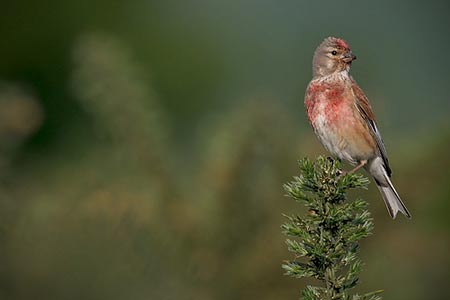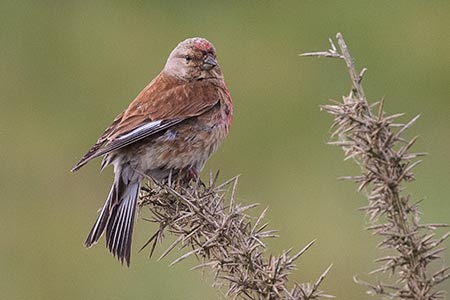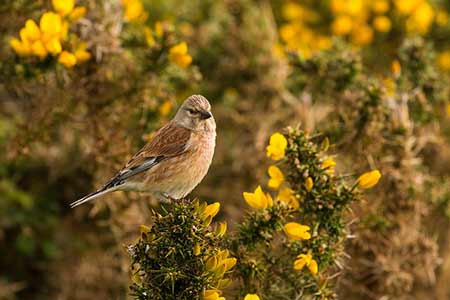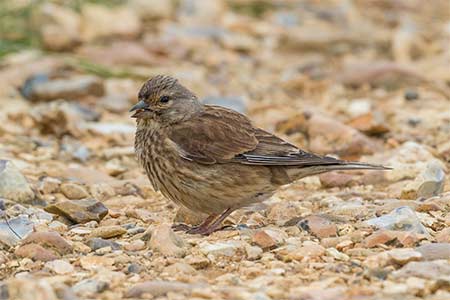Linnet (Linaria cannabina)
(1) Where, when and how many

(© John / CC BY-NC-ND 2.0)
When: On the Crown Lands, Linnets are typically present from late winter or early spring through to late summer or autumn: whilst around the National Park coastline and along the western edges of the National Park, they occur all the year round, mainly in relatively small numbers.
How many: Linnets are relatively common and widespread as a breeding bird on the Crown Lands. They are also relatively widespread elsewhere in Hampshire - on farmland, downland, heathland and along the coast - although significant declines have occurred in many places due, at least in part, to agricultural intensification and the resultant decrease in foodstuffs - seeds feature prominently in their diet, although some invertebrates are also taken - and suitable hedgerow and other nesting places.
(Nationally, numbers declined by around 75% between 1965 and the late 1980s, whilst Breeding Bird Survey results for south-east England showed a 43% reduction between 1995 and 2012. The Linnet is red listed as a bird of conservation concern).
Linnets are the amongst the New Forest's most attractive birds, delightful small finches that brighten many a walk with their twittering calls and conversational songs. It helps, too, that they first appear on the Crown Lands each year just when the gorse is in glorious bloom in their favoured heathland habitats.

Many Linnets are migrants, not in the sense that after the breeding season, they depart for Africa or other far-flung places, but in-so-much as the majority usually desert the New Forest and spend the winter elsewhere, often turning up on the coasts of Britain in late summer and autumn before hopping across the Channel to enjoy warmer weather farther south in western France and Portugal.
But outside the breeding season, relatively large flocks are still often recorded in Hampshire, frequently on winter stubble fields where an abundance of seeds are left on the ground. Between January and March, 2017, for example, there were 14 counts of 150 or more, with the highest count during this period being of at least 350 birds at Easton, a little to the north-east of Winchester.
(2) Description

(© James West / CC BY-NC-ND 2.0)
Seen from a distance, particularly with the naked eye, Linnets can appear to be no more than twittering little brown birds, but when viewed from close range, breeding season males are wonderfully marked, boasting a pinky-red patch on the forehead and the same colour breast to complement their chestnut back, grey head and whitish-buff chest and throat. Colours fade after the late summer / early autumn moult although the basic pattern is retained by the males throughout the year.
Both sexes have noticeably white markings in the wings and relatively long forked tails. Females and juveniles lack pinky-red plumage.
Flight is noticeably undulating and, unlike the stonechats that share their heathland and coastal homes, Linnets are particularly wary and will often flee in a small, twittering flock whilst any perceived source of danger is still quite a distance away - they certainly have good reason to be wary, for in the 19th century they were often caught and kept in captivity as cage birds.

(3) Nesting behaviour
Linnets have a long nesting season which starts in mid-April and sometimes continues right the way through to mid-August. They often live in small, loose colonies, typically of four to six pairs, although individual territories are maintained and defended against others of the same species.
In the New Forest, nests are often built low down in the inaccessible depths of gorse bushes. Four to six eggs are commonly laid, incubation lasts between 12 and 14 days and the youngsters fledge after a further 10 to 17 days.
(4) Country names
Reflecting the Linnets one-time status as an attractive, extremely common and widespread bird, they have been blessed with many local, country names including the very descriptive Red Linnet, Blood Linnet, Rose Linnet, Red-breasted Linnet and Red-headed Finch. Perhaps most appropriate to the New Forest, however, are names reflecting habitat preference, such as Gorse Bird, Furze Bird and other similar names incorporating gorse or furze.
References:
Hampshire Bird Atlas 2007-12: edited by John Eyre
Hampshire Bird Report: 2017 and 2018
Collins Bird Guide: Mullarney, Svensson, ZetterstrÖm and Grant
Handbook of the Birds of Europe, the Middle East and North Africa, The Birds of the Western Palearctic (volumes 1-9): Stanley Cramp, et al
All the Birds of the Air: Francesca Greenoak
Quick links
More links
Search this site

